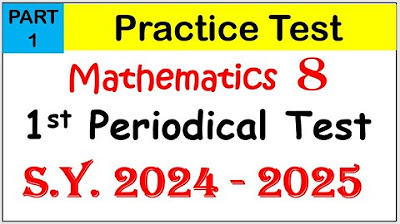Suma o diferencia de cubos ejemplos de factorización
Summary
TLDRIn this video tutorial, the instructor teaches the process of factorization through the sum and difference of cubes. He demonstrates key steps such as identifying perfect cubes, extracting cube roots, and applying formulas to factor expressions. Detailed examples are provided, including how to handle roots and exponents, and step-by-step guidance is given for both sum and difference of cubes. The instructor also emphasizes common student errors and tips to avoid them. Viewers are encouraged to practice with exercises and refer to earlier content for foundational knowledge on factorization.
Takeaways
- 😀 Factoring sums and differences of cubes is an essential topic in algebra that requires understanding cube roots and specific formulas.
- 😀 Before diving into factoring, it's important to learn how to calculate cube roots, as shown in the introductory video.
- 😀 A difference of cubes can be factored using the formula: (a - b)(a^2 + ab + b^2), where 'a' and 'b' are the cube roots of the terms.
- 😀 In the first example, the difference of cubes 8x^3 - y^3 is factored by first calculating the cube roots of 8 and x^3, which are 2 and x, respectively.
- 😀 The correct application of the difference of cubes formula is crucial: the first root is written negatively, followed by the squared terms and product of the roots.
- 😀 For sums of cubes, the formula is (a + b)(a^2 - ab + b^2), which requires recognizing whether the expression is a sum or difference of cubes.
- 😀 In the second example, the sum of cubes is factored by first finding the cube roots of 27, m^3, 125, and n^6, which are 3, m, 5, and n^2, respectively.
- 😀 One key mistake to avoid is incorrectly squaring only part of the root. Always square the entire first root when applying the formula.
- 😀 The instructor emphasizes the importance of performing operations carefully, such as correctly applying exponents when terms are squared or multiplied.
- 😀 The video concludes with a reminder for viewers to practice by pausing and trying the exercises on their own, reinforcing their understanding of the material.
Q & A
What is the focus of the video tutorial?
-The video tutorial focuses on the process of factorizing cubic expressions, specifically using the sum or difference of cubes method.
What is the first step when factorizing cubic expressions by sum or difference of cubes?
-The first step is to find the cube roots of the terms involved in the expression.
How do you find the cube root of 8 in the example?
-The cube root of 8 is 2, as 2 cubed equals 8.
What is the formula used for factorizing the difference of cubes?
-The formula for factorizing the difference of cubes is: (a - b)(a² + ab + b²), where a and b are the cube roots of the terms.
How do you handle the negative sign when applying the difference of cubes formula?
-When applying the difference of cubes formula, the first term is negative, and you follow the pattern for the difference of cubes: (a - b)(a² + ab + b²).
What mistake do students often make when calculating the square of the first root in the formula?
-Students often make the mistake of squaring only the first part of the root, instead of squaring the entire root expression.
How is the cube root of 27 calculated?
-The cube root of 27 is 3 because 3 cubed equals 27.
What happens when the exponents in the cubic terms are not simple integers, such as in the case of x^12?
-When the exponents are not simple integers, you divide the exponent by 3 to find the cube root. For x^12, the cube root is x^4.
What is the importance of correctly applying the exponents when squaring terms in the factorization?
-Correctly applying exponents is essential because it ensures that terms are simplified accurately, especially when dealing with compound terms like x^4 or x².
What did the instructor suggest for students to practice factorizing cubic expressions?
-The instructor encouraged students to pause the video and practice on their own, with the answers to the exercises provided afterward for self-checking.
Outlines

This section is available to paid users only. Please upgrade to access this part.
Upgrade NowMindmap

This section is available to paid users only. Please upgrade to access this part.
Upgrade NowKeywords

This section is available to paid users only. Please upgrade to access this part.
Upgrade NowHighlights

This section is available to paid users only. Please upgrade to access this part.
Upgrade NowTranscripts

This section is available to paid users only. Please upgrade to access this part.
Upgrade NowBrowse More Related Video

Factorización suma o diferencia de cubos conceptos previos

Factoring Polynomials using Greatest Common Monomial Factor

Factoring Sum and Difference of Two Cubes: Grade 8 Math

Q 1-Ex 7.1-Cube and Cube Roots-NCERT Maths Class 8th-Chapter7

[Tagalog] First periodical test #math8 #periodicaltest #firstquarter #factoringpolynomials PART I

Multiplying Rational Expressions
5.0 / 5 (0 votes)